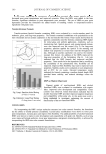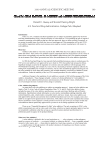18-MEA AND HAIR APPEARANCE 155 Table III The Relative Ion Yield of 18-MEA vs the CN Ion Yield and Contact Angles of Hair (n = 5) Untreated hair 18-MEA-removed hair The relative ion yield of 18-MEA vs the CN ion yield 0.37 ± 0.14 0.00 Contact angles Advancing 102.9° ± 4.8° 88.0° ± 4.8° Receding 60.0° ± 9.0° 3.2° ± 5.5° 18-MEA-removed hair were 0.37 ± 0.14 and 0.00, respectively. The advancing contact angles for untreated hair and 18-MEA-removed hair were 102.9° ± 4.8° and 88.0° ± 4.8°, respectively. The receding contact angles for untreated hair and 18-MEA-removed hair were 60.0° ± 9.0° and 3.2° ± 5.5°, respectively. It was confi rmed that 18-MEA on the out- ermost surface was essentially removed by this procedure. It was also confi rmed that the Table II Structural and Physical Properties of Hair (n = 7) Untreated hair 18-MEA-removed hair SEM image Diametric swelling ratio in water (%) 1.08 ± 0.02 1.08 ± 0.15 Elastic modulus in water (× 1010 dyns/cm2) 1.77 ± 0.26 1.68 ± 0.53 Breaking stress in water (× 109 dyns/cm2) 1.75 ± 0.24 1.82 ± 0.24 Figure 9. Typical FFM images for (a) untreated hair and (b) 18-MEA-removed hair in water at 2-μm × 2-μm scan size. Darker areas correspond to a lower friction force and brighter areas correspond to a higher friction force.
JOURNAL OF COSMETIC SCIENCE 156 reduction of 18-MEA led to a larger decrease in the receding contact angle, 60° to 3°, compared to that of the advancing contact angle, 103° to 88°. Figure 9 shows typical FFM images for untreated hair and 18-MEA-removed hair in water, and the average values of the friction force are shown in Figure 10. The bars represent means for n=5, and the whiskers represent the standard deviations. The asterisk symbol in Figure 10 indicates the p-value obtained from Student’s t-test. There was a signifi cant difference in the friction forces between untreated hair and 18-MEA-removed hair. The removal of 18-MEA led to an increase in friction forces in water. Figure 11 shows schematic diagrams of hair interactions in the wet state. A higher reced- ing contact angle and a lower friction force in the wet state allow untreated hair fi bers to move more easily over each other and realign with each other. The fact that the removal of 18-MEA decreased the receding contact angle suggests that 18-MEA-removed hair will remain wet longer and create a stronger adhesive force between hair fi bers and make the hair fi bers tend to aggregate together in the wet state. The fact that 18-MEA-removed hair gave a higher friction value suggests that 18-MEA-removed hair will be easier to tangle. It was thus expected that the combination of the decrease in receding contact angle and the increase in the friction force in the wet environment for 18-MEA-removed hair will affect hair alignment adversely in the wet state. Figure 10. Friction forces of (a) untreated hair and (b) 18-MEA-removed hair in water. The bars represent means for n=5 the whiskers represent the standard deviations. The asterisk symbols indicate the p-values obtained from Student’s t-test **p 0.01. Figure 11. Schematic diagram of hair interactions in wet environment.
Purchased for the exclusive use of nofirst nolast (unknown) From: SCC Media Library & Resource Center (library.scconline.org)





































































































































